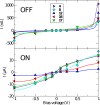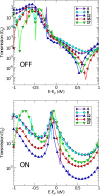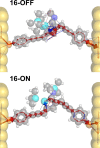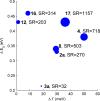New Class of Molecular Conductance Switches Based on the [1,3]-Silyl Migration from Silanes to Silenes
- PMID: 23741530
- PMCID: PMC3670211
- DOI: 10.1021/jp400062y
New Class of Molecular Conductance Switches Based on the [1,3]-Silyl Migration from Silanes to Silenes
Abstract
On the basis of first-principles density functional theory calculations, we propose a new molecular photoswitch which exploits a photochemical [1,3]-silyl(germyl) shift leading from a silane to a silene (a Si=C double bonded compound). The silanes investigated herein act as the OFF state, with tetrahedral saturated silicon atoms disrupting the conjugation through the molecules. The silenes, on the other hand, have conjugated paths spanning over the complete molecules and thus act as the ON state. We calculate ON/OFF conductance ratios in the range of 10-50 at a voltage of +1 V. In the low bias regime, the ON/OFF ratio increases to a range of 200-1150. The reverse reaction could be triggered thermally or photolytically, with the silene being slightly higher in relative energy than the silane. The calculated activation barriers for the thermal back-rearrangement of the migrating group can be tuned and are in the range 108-171 kJ/mol for the switches examined herein. The first-principles calculations together with a simple one-level model show that the high ON/OFF ratio in the molecule assembled in a solid state device is due to changes in the energy position of the frontier molecular orbitals compared to the Fermi energy of the electrodes, in combination with an increased effective coupling between the molecule and the electrodes for the ON state.
Figures











References
-
- Song H.; Reed M. A.; Lee T. Adv. Mater. 2011, 23, 1583–1608. - PubMed
-
- van der Molen S. J.; Liljeroth P. J. Phys.: Condens. Matter 2010, 22, 133001. - PubMed
-
- Galperin M.; Nitzan A. Phys. Chem. Chem. Phys. 2012, 14, 9421–9438. - PubMed
-
- Fuentes N.; Martn-Lasanta A.; Álvarez de Cienfuegos L.; Ribagorda M.; Parra A.; Cuerva J. M. Nanoscale 2011, 3, 4003. - PubMed
-
- Liao J.; Agustsson J. S.; Wu S.; Schönenberger C.; Calame M.; Leroux Y.; Mayor M.; Jeannin O.; Ran Y.-F.; Liu S.-X.; et al. Nano Lett. 2010, 10, 759–764. - PubMed
LinkOut - more resources
Full Text Sources
Other Literature Sources
Miscellaneous
